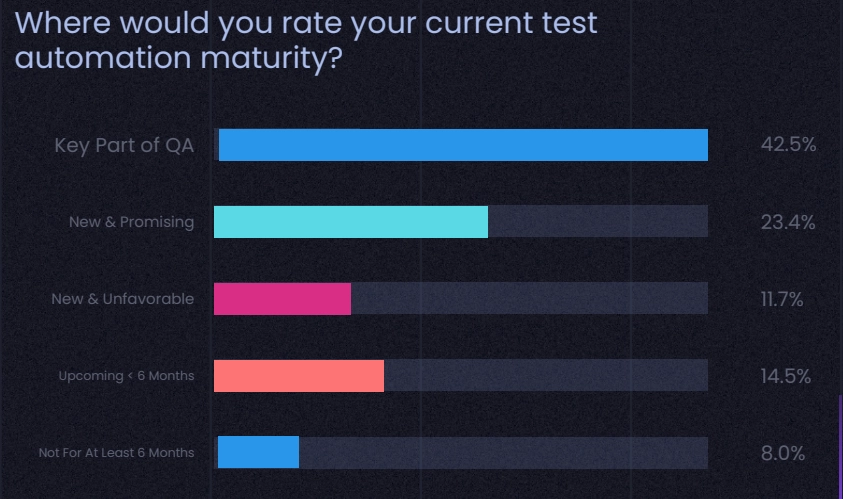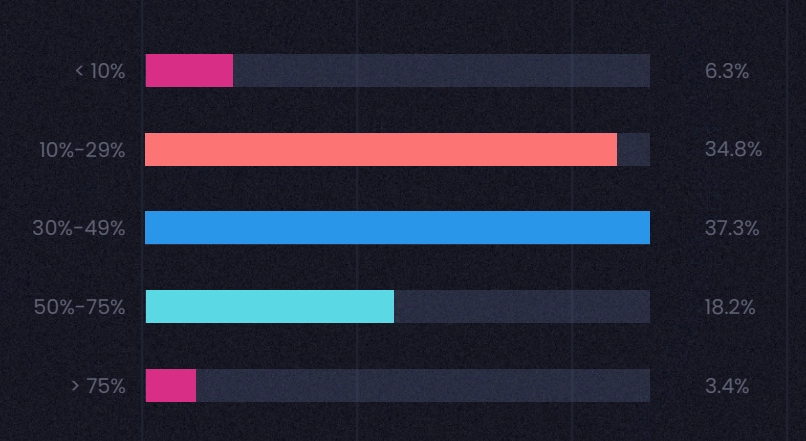Test automation can provide faster and more efficient tests than manual testing. 1 Automating testing also offers benefits such as increased test coverage and accuracy. The interest in test automation has been increasing over the years.
We present top statistics that show its benefits, trending practices, and rate of adoption by your competitors. See the section you’re most interested in by following the links below:
- Automation testing vs. manual testing
- Automated test adoption
- Test development models/frameworks
- Market size & growth
Automation testing vs. manual testing
It has been established that performing repetitive manual testing on large software systems or those with comprehensive dataset coverage is challenging. 2
Below, you can see statistics supporting organizations’ goals of moving from manual testing to automation testing.
- Manual testing is the most time-consuming activity in the testing cycle ( see Figure 1).
- Test Automation has replaced 50% or more of the manual testing efforts in 46% of the cases(See Figure 2). 3
Figure 1. The most time-consuming activities within a test cycle4

Figure 2. Effect of automated testing on effort reduction 5

Automated test adoption
These percentages of testers claimed 6 7 to use automated testing or scripting for:
- Functional and regression testing: 73%
- Unit testing: 45%
- CI/CD: 44%
- Load and stress testing: 31%
Moreover,
- 55% of companies claimed to pursue automated testing strategies cite quality improvement, and ~30% cite time to market as their primary driver
- ~42% of companies indicated that test automation is a key part of QA (Figure 4)
- Most companies using test automation allocate 10% to 49% of the QA budget to test automation (See Figure 5).
- 26% of companies surveyed indicate finding the right test automation tool as the biggest challenge they face. To understand more about automation testing tools, read “Top Test Automation Tools: Detailed Benchmarking“
- ~33% of companies seek to automate between 50% to 75% of their testing process, while ~20% aim to automate more than 75% of the testing process.
- ~24% of companies have achieved more than 50% of test automation in their testing process.
- ~24% of companies adopting test automation indicate stability as a surprise they have encountered.
Figure 4. Current test automation maturity8

Figure 5. Test automation budget allocation 9

Test development models/frameworks
Based on a survey 10 :
- Test-driven development as a development framework was used 18% of the time.
- In DevOps as a development model was used 38% of the time.
- API testing is an essential skill that the tester should be familiar with. 97% of responders indicated that API testing is crucial for their operational success.
- 99% of responders indicated that functional test automation and test scripting are crucial for them.
Market size & growth
According to KPMG 11 ;
- The global test market exceeded $40 billion in 2020.
- The global test market is expected to grow between 7% to 12% CAGR between 2021 and 2025.
External Links
- 1. A Journey from Manual Testing to Automated Test Generation in an Industry Project | IEEE Conference Publication | IEEE Xplore.
- 2. International Journal of Engineering and Innovative Technology (IJEIT) “Quantitative Analysis of Automation and Manual Testing”
- 3. The 2025 State of Testing™ Report.
- 4. 2025 State of Continuous Testing Report | BlazeMeter.
- 5. The 2025 State of Testing™ Report.
- 6. The 2025 State of Testing™ Report.
- 7. State of Test Automation 2020-2021: An Industry Survey from Kobiton.
- 8. State of Test Automation 2020-2021: An Industry Survey from Kobiton.
- 9. State of Test Automation 2020-2021: An Industry Survey from Kobiton.
- 10. The 2025 State of Testing™ Report.
- 11. KPMG “Software Testing“



Comments
Your email address will not be published. All fields are required.